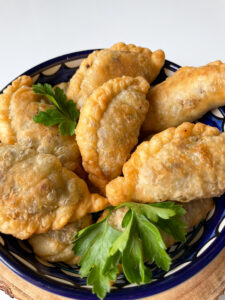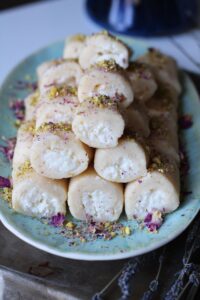RAMADAN WEEKLY RECIPE COLLECTION 2
Looking for a new dish to include for Iftar or just want to impress your friends with some Palestinian cuisine? Look no further, UPA is Extending the Table by offering you these delicious recipes from our friend and supporter Nida Khalaf.
Meat Sambousek

Sambousek is a Ramadan appetizer favorite, they are made with either meat or cheese. In preparation for Ramadan, many families make and store sambousek in the freezer ahead of time. This way this delicious yet very simple appetizer gets served throughout the month of Ramadan without a lot of prep or work.
Prep: 20 mins
Cook: ~2-3 mins
Ingredients:
- 1 pack frozen puff pastry
- The meat filling:
- 500g minced beef
- 1 large onion finely chopped
- 1.5 tbsp pine nuts
- 1.25 tsp 7 spice
- 1 tsp salt (to taste)
- ½ tsp black pepper
- 1 tbsp vegetable oil
- 1 tbsp ghee
- 2 cups vegetable oil for frying
Method:
- In a medium-sized pan over high heat, add the vegetable oil and ghee, add the meat and cook for 3-5 mins. Then add the chopped onion and the spices; let them cook until done; this should take around 10-12 mins, stir in the pine nuts and set aside and allow the meat to get to room temperature.
- Let the dough thaw by following the pack’s instruction. Using a rolling pin flatten the dough, thinning it to a pizza like crust (i.e. similar thickness).
- Using a cookie cutter or a cup, cut the dough into small circles ~4 inches in diameter.
- Fill each circle with a spoonful of the meat filling, fold it and using a fork score the edges to seal them or alternately twist the edges using your hands.
- In a pan heat up the vegetable oil on high, reduce the heat to medium and shallow fry the sambousek for 1-2 mins on each side or until golden brown, place on a paper towel to allow the oil to absorb and enjoy as an appetizer.
Note: if you plan to prep these in advance and store them in the freezer, simply store the uncooked filled sambousek in ziplock bags in the freezer, once ready for cooking, take them out let them thaw for an hour or so and fry them.
Shush Barak

Shush Barak is a classic staple of the Levantine cuisine, made of small meat dumplings simmered in a garlic mint yogurt sauce. Shush Barak is served as a dumpling soup or with a side of vermicelli rice. This dish is one of my all time favorite dishes. Some families make it with Cilantro instead of mint, but in my family we make it with mint and I think its glorious
Ingredients:
The dough:
- 2.5 cups flour
- ¾ -1 cups of water
- ½ tsp salt
The meat filling:
- 500g of minced beef
- 1 large onion finely chopped
- 2 tbsp pine nuts
- 1.25 tsp 7 spice
- 1 tsp salt (to taste)
- ½ tsp black pepper
- 1 tbsp vegetable oil
- 1 tbsp ghee
- 2 tsp dried mint
The yogurt sauce:
- 1.25-litre plain yogurt (I use Astro)
- 1.5 tbsp corn starch
- 1 egg yolk (optional)
- 2.5 cups chicken stock
- 1.5 tsp chicken Bouillon (I use Knor)
- 2 cloves of minced garlic fried in 1 tbsp olive oil
- 1 clove of minced garlic
- 2 tsp dried mint
Method:
- Prep the dough by mixing all the ingredients and knead for 10 mins. Let it rest for 30 mins loosely covered by a kitchen towel.
- In a medium-size pan over high heat, add the vegetable oil and ghee, add the meat and cook for 3-5 mins. Then add the onion and the spices; let them cook until done; this should take around 10-12 mins, stir in the pine nuts and mint and set aside.
- Allow the meat to get to room temperature and assemble the Shush Barak. Cut the dough into 2 portions, and using a rolling pin, roll the dough very thin (almost sheet thin). Using an espresso cup or a cookie cutter of a similar size, cut the dough into equal circles.
- Take each dough circle, fill it with meat, fold it into a half-moon shape and pinch both ends together to form the dumpling / Shush Barak; repeat until you finish the dough and meat mixture.
- Once done, place on a parchment paper-covered baking tray (a cookie sheet is perfect) and bake at 350F for 15 mins.
- In a large pot, add the cold yogurt, corn starch and egg yolk. Thoroughly whisk fast while cold for 3 mins. This step is critical as it ensures the yogurt sauce holds. Turn the heat to medium-low and continue whisking until the yogurt comes to a boil (do not stop whisking); this should take 15-20 mins.
- In a separate pan, fry the two cloves of garlic with the olive oil until slightly golden.
- Once the yogurt boils, add the chicken stock, the minced garlic, the fried garlic and the mint continue cooking for an additional 5 mins.
- Drop in the dumplings into the yogurt sauce and let it cook on low for 20-25 mins on low.
- Serve as a dumpling soup or with vermicelli rice.
Halawet Al Jibin

Ingredients:
- ¾ cup fine semolina (#1)
- 1.25 cups water
- ¼ cup sugar
- 300g fresh mozzarella cheese cut into small cubes (you can also use halloumi; I would suggest 200g mozzarella and 100g halloumi)
- 2 tbsp ghee for brushing
The Eshta filling:
- 2 Liters of whole milk + ¼ cup of vinegar
- 1 Liter of whole milk
- ½ cup corn starch
- ¼ cup of sugar
- 2 tsp rose water
- 1 tbsp orange blossom water
Orange Blossom water syrup:
- 2 cups of sugar
- 1 cup of water
- A couple of drops of lemon juice
- ½ tsp orange blossom water
Method:
Note: Prep the Eshta (Clotted cream) and the simple syrup in advance, I highly recommend the night before. The syrup should be at room temp, so store it outside in a mason jar
- In a medium-sized pot, pour 2 liters of milk, bring to a near boil on medium heat (stirring occasionally to prevent the milk from burning), then add the vinegar and reduce the heat to low. The milk will start clotting.
- Using a strainer ladle skim the clotted cream or curds from the surface and place it in a sieve; repeat until you collect all the clotted cream leaving the ‘water behind’; and set it aside.
- In another pot, pour the 1 liter of milk, the corn starch and the sugar; whisk while the milk is cold to prevent the corn starch from clotting. Place on medium-low heat, and continuously whisk until the milk thickens; once the milk thickens, add the orange blossom and rose water and the clotted cream. Mix well and pour into a bowl. Cover using a plastic wrap; once it reaches room temperature, place in the fridge for at least 2-3 hours or overnight.
- To make the syrup, simply add the sugar, water, 2-3 drops of lemon in a pot, cook on medium high for 10 mins until the sugar fully dissolves, let it boil and simmer for 5 additional mins until it slightly thickens, turn off the heat and add the orange blossom water. Set aside.
- Now, lets prep Halawet Al Jibin! In a medium (non-stick) pan, add the water, semolina and sugar and bring to a simmer on medium-low heat until the mixture forms and thickens.
- Slowly add the cheese, and using a wooden spoon, whisk until the cheese melts and the mixture turns into a dough; you’ll know it’s ready once the mixture stretches without breaking; this should take 15-20 mins! This process is quite an arm workout! Note, key to success here is to add the cheese in iterations I would recommend 3 iterations.
- Once done, divide the mixture into 4 portions, place a plastic wrap on your countertop, and brush it with some of the ghee and 1 tbsp of orange blossom syrup. Place the dough and another wrap on top and roll the dough very thin; remove the top layer wrap, place a line of Eshta around the edges and roll until you form a cylinder repeat until you finish them all. You should have 4 cylinders of Halawet Al Jibin.
- Wrap the cylinders in plastic wrap and place them in the freezer for 30 mins, and it’s ready to serve.
- Garnish with some pistachio and enjoy with a drizzle of simple syrup.
ABOUT NIDA KHALAF
Nida Khalaf was born and raised in Ramallah, Palestine. She later moved to North America to pursue higher education and settled in Toronto. For Nida, food, family, and culture are intimately tied up; food serves as a memory and a human connection. Preserving recipes passed down from her loved ones and sharing them with her own unique twist, gives her a wonderful sense of nostalgia for her childhood home and the people with whom she shared the cooking and dining experience. Follow Nida on Instagram!

